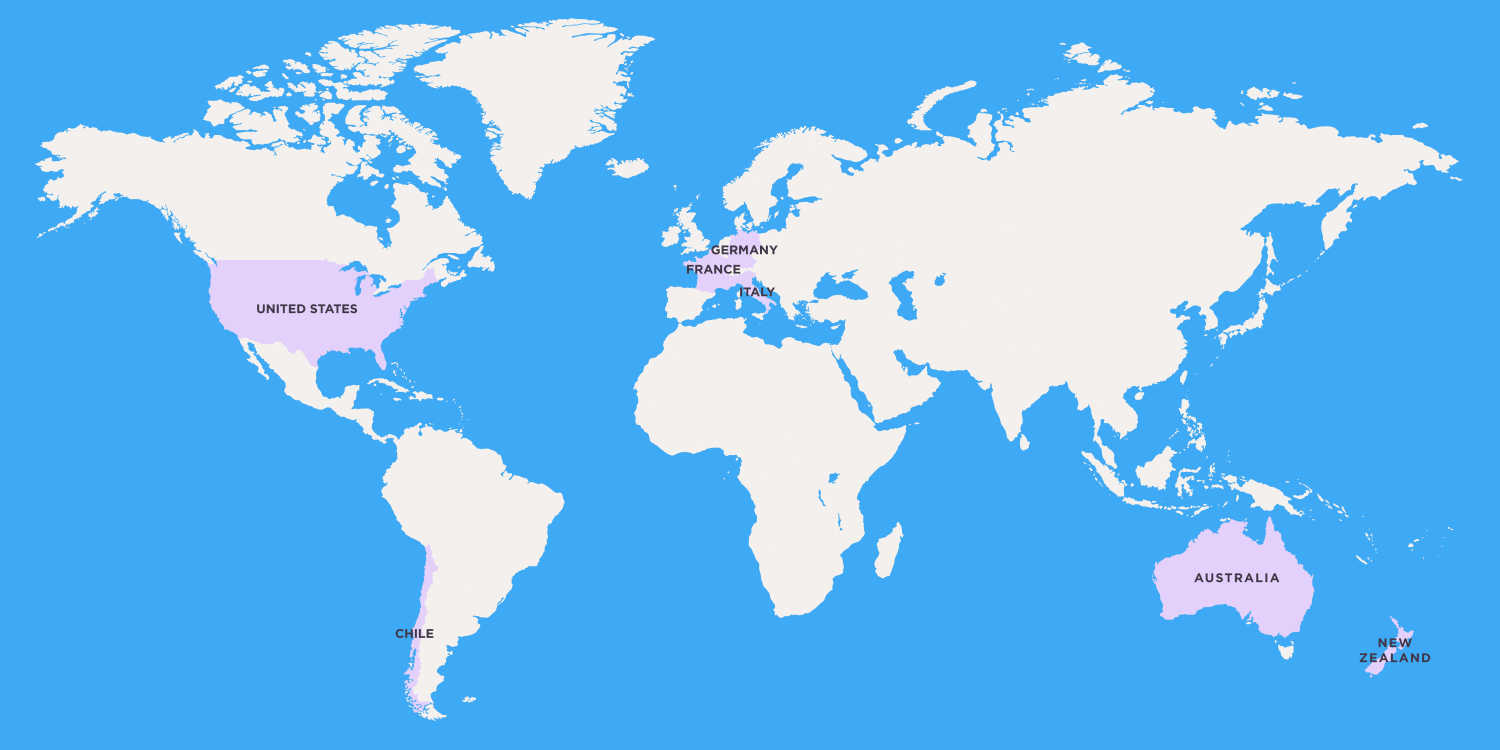Pinot Noir
The only rule for Pinot Noir is that the wine must be delicious
Pinot Noir is truly a gift to wine lovers everywhere. A tricky grape in the vineyard and in the cellar, the hard work it demands is invariably rewarded. When Pinot Noir is good, it might just be the best wine in the world. Unlike many of the major international varieties, today there is no truly set flavor profile or style for winemakers that choose to pursue Pinot Noir. The only rule is that the wine must be delicious.
The grape came into its own in the Burgundy region of France, and for a long time Pinot Noir winemakers were held to those standards. But in the past few decades, cool-climate vineyards in the New World have delivered a new era of Pinot Noir. These New World winemakers have changed their focus to showcase their own flavors and styles instead of simply copying Burgundy and hoping for the best. This is amazing progress for wine drinkers who love subtle and distinct wines.
Whether you like an earthy Burgundy, Champagne Blanc de Noirs (all red grapes used to make white, sparkling wine), the strawberry flavored examples from Carneros, the dark fruit flavors of the Russian River Valley in Sonoma County, elegant high-acid wines from Central Otago in New Zealand, or the eucalyptus-scented Pinot Noirs from Chile you are in for a treat, because great Pinot Noir is heady and known for its finesse, complexity, and subtlety.

Take The Quiz
Learning about different wine varietals and regions is fun. Take the quiz now to explore wines matched to your unique palate.
Take The QuizIN THIS ARTICLE:
Want personalized wines?
Get your first box of wines for $44.95 + free shipping.

History of Pinot Noir
Pinot Noir (pronounced pee-no no-wahr) berries come in many different hues but are mostly known for being temperamental—showing large amounts of variation from year to year. The name is derived from the French terms for "pine" and "black," as the tightly clustered berries resemble a pine cone.
Originating in antiquity, Pinot Noir is one of the oldest cultivated varietals that we still use in contemporary winemaking. A grape that is universally believed to be Pinot Noir was described in the 1st century by a Roman agricultural writer, who mentioned thriving vines in Burgundy, cementing the grape with the region from the get-go.
Fun Fact
In the film Sideways, one of the main characters refuses to drink Merlot in favor of Pinot Noir. This led to the slowing of Merlot sales for almost a decade as wine drinkers explored Pinot Noir.
The first officially documented mention of the Pinot Noir grape comes from the mid-fourteenth century in the form of a blanket ban of lesser grapes on the Côte-d'Or in Burgundy. Pinot Noir was declared the best grape for the region, and since that time has reigned supreme.
Despite being so popular in Burgundy, it took some time to catch on in other French winemaking regions. It wasn’t introduced to Italy until the early 1800’s, and it wasn’t until the past few decades that Pinot Noir spread and flourished in the rest of the wine-drinking world.
Now we find it growing largely in cold-weather regions (and a few warm ones) around the globe: Burgundy; Champagne; Germany (where it is called Spätburgunder); Austria (where it is called Blauer Burgunder); Italy (where it goes by Pinot Nero); Carneros, California; Russian River, California; Oregon (the closest New World equivalent to Burgundy); Australia; Chile; and South Africa.
What does Pinot Noir taste like?
Pinot Noir is truly an international grape, and it comes in many different styles but the best examples are marked by subtlety. “Old World” Pinot Noir (especially Red Burgundy from the Côte-d'Or) is incredibly complex and takes time to develop and mature. It is known for being delicious in youth and in old age, but on occasion, it hits an awkward aging phase in the middle. But it bears remembering that like most other wines, 99% of all Pinots (no matter the location they come from) are meant to be consumed young.
Burgundy wines feature complex flavors with light tannins and subtle notes of strawberry or black cherry, a touch of spice, leather, smoke, and a note that is commonly called “wild game.” Winemakers in the Côte-d'Or are influenced by the philosophy of terroir or “the taste of a place.” Aged Pinot Noir from these vineyards can develop a note that many describe as "forest floor." What is most important to the winemakers is that the earthy qualities of Pinot Noir shine through. Terroir driven wines are meant to share basic characteristics, but to show the unique characteristics that come from their vineyards.
Not all Pinot Noir needs to taste like Burgundy. There are many examples that are more fruit-forward with red fruit flavors like raspberry dominating the wine. And there are even light sparkling wines that showcase the subtlety a winemaker can showcase with the grape. The one rule is that the best examples of Pinot Noir worldwide veer away from tasting baked, jammy, and over oaked.
Fun Fact
We also have Pinot Noir to thank for some of the world’s favorite grape varieties: Chardonnay, Gamay, Aligote, and Pinotage are all related to the Pinot family.
Pinot Noir Characteristics
Pinot Noir is made in many different styles but it generally has a medium body, light flavors, low acidity, and medium to low tannins. The red berries have thin skins, which makes the grape difficult to cultivate. It thrives in chalky clay soils but is known for expressing terroir in the final wine.
The best examples have a sensual mouthfeel and a bouquet that ensnares the senses. Common tasting notes to look for are strawberry, cherry, leather, wild game, charcuterie, and mushrooms.
Fun Fact
Ampelographers (Botanists who study grapes) view Pinot Noir as the same grape as Pinot Blanc and Pinot Gris.
Pinot Noir Nutritional Facts
The nutritional value in Pinot Noir varies greatly depending on two main factors: alcohol and sugar. Some Pinot Noir is sweet, some Pinot Noir is dry, but the more sugar present in a wine, the more carbohydrates.
The alcohol in Pinot Noir can vary greatly depending on how ripe the grapes were when harvested if the winemaker added extra sugar, and how long it was allowed to ferment. Pinot Noir is generally a medium to medium-low alcohol wine.
How to Serve and Store Pinot Noir
Serving Pinot Noir can be done simply. The wine should be opened and allowed to breathe. Enjoy at a temperature between cellar and room temperature. If you want to experience the wine through multiple stages we recommend popping the bottle of Pinot Noir in the refrigerator for 15 to 30 minutes before serving and allowing it to warm as you drink it, but this is all personal preference. Enjoy your wine how you like it.
Once your wine is slightly cooled it is time to open the bottle. Most likely you will need a standard corkscrew, but if you have a particularly old bottle of wine, you might prefer to use a two-prong Butler's thief cork puller.
Pinot Noir does not typically need to be decanted, and avid Burgundy drinkers believe it is a sin to decant as the wines do not deposit much sediment while aging. It should be noted that Pinot Noir is known for fickle aging, and even wines made in the same style from the same winery age differently depending on the vintage. Like most wines, 99% of all Pinots are meant to be consumed young.
Pinot Noir should always be stored in a cool place that does not receive direct sunlight, and preferably in a wine refrigerator or cellar. 55 degrees Fahrenheit is the median temperature wine should be stored if you wish to age the bottles. What matters most is consistency. Do not store your Pinot Noir in a place that receives direct sunlight, heat, or too much humidity.
What to Pair with Pinot Noir
Pairing wine has some general rules, but we think the most important rule is to drink Pinot Noir with the food you like. With Pinot Noir, however, you are particularly lucky and it goes with almost everything. It is as good with Burgundian classics as it is with grilled meats, charcuterie, roasted vegetables, and even grilled fish.
Pinot Noir Wine Regions
Pinot Noir is truly an international grape. Here is a brief overview of where it is growing.
France:
For two millennia Pinot Noir has been produced in Burgundy, and nowhere in the world is more important for the development of the grape than the Côte-d'Or. With the city of Beaune at the center, this is home to the Grand Cru and Premier Cru Burgundies that you might have heard some wine drinkers rhapsodizing about. It planted all over the region, with each appellation expressing its own terroir.
Pinot Noir is also grown extensively in Champagne where it is largely used for sparkling wine blends. The juice of the Pinot Noir berries runs clear and therefore can be used to make elegant, effervescent wines. Blanc de Noirs, sparkling white wines featuring all dark grapes are particularly delicious and feature Pinot Noir and Pinot Meunier heavily.
Germany:
Germany is the third-largest producer of Pinot Noir (where the grape is called Spätburgunder) in the world. As climate change has begun to reshape the winemaking map, we are seeing better and better examples of Pinot Noir coming from regions like Baden, Rheingau, and the Pfalz. It has gained a lot of space in the vineyards and is now the most widely planted red wine grape in the country.
Italy:
Introduced to central Italy in the early 1800s, the Pinot Noir grape (Pinot Nero in Italian) took a while to mature. The past few decades have seen a massive increase in quality with excellent versions coming from Alto Adige (Sudtirol).
United States:
California Pinot Noir proves that not all Pinot Noir needs to be made like Burgundy. The wines coming out of California regions (especially Carneros, the Russian River Valley, the Anderson Valley, and Santa Barbara among other Central Coast AVAs, Napa, and the Sonoma Coast) are rich, complex, and delicious.
Other areas in the country producing delicious examples include the Willamette Valley, Oregon, Washington State, and the Finger Lakes region of New York State.
Australia:
Like most other parts of the New World, it took winemakers in Australia some time to figure out how to make good Pinot Noir, but thankfully the winemakers of Yarra Valley, Adelaide, Mornington, and Tasmania have hit their stride and are making delicious wines that showcase the terroir or Australia.
New Zealand:
Pinot Noir coming out of New Zealand is incredibly exciting. The cool climates with lots of sunshine are perfect for ripening these tricky grapes. The vineyards of Martinborough and Central Otago are particularly delicate and expressive and are producing the best Pinot Noir in the country.
Chile:
Chilean Pinot Noir is rapidly gaining in quality. One note that comes through in these wines is eucalyptus, which adds a fun scent to an already exciting wine.
IN THIS ARTICLE
Want personalized wines?
Get your first box of wines for $44.95 + free shipping.


WinePrint™ by Firstleaf
Are you looking to learn more about your wine preferences? Check out our Wine Print for an in-depth look at your personal tasting profile. Discover your favorite wines, varietals, regions, and tasting notes and get personalized recommendations wherever you are.
Learn More
